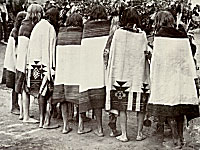History
Culture
Design &
Technique
How
To
Artists
Convocation
Glossary

Home |
Pueblo embroidery today is the most viable and commonly practiced
of all the Pueblo textile traditions, which date back more than
a thousand years.

Hopi Dancers, c. 1900.
|
|
|
The
thunder is always in the middle, and then you have the steps
on the side, and the rain. Those are always the same, you can’t
change.
—Lydia Chinana, embroiderer, Jemez Pueblo |
The
origin of embroidery as a primary decorative technique of the Pueblo
people remains obscure, because few prehistoric textiles have survived
centuries of climate change.
However, embroidery’s importance in the embellishment
of ceremonial clothing has assured its continued use over hundreds of years.
At the same time, embroidery’s connection
to private religious ritual has limited the potential of embroidered Pueblo textiles
to be appreciated by the non-Indian public and the Southwestern art market.
The story of Pueblo embroidery begins over 1500
years ago, when people began to weave textiles in the Southwest, and spans the
era of conquest and occupation by the Spanish beginning in the sixteenth century,
through the rise of the Southwest’s popularity as a tourist destination
in the twentieth century.
Today’s Pueblo embroiderers sustain the
traditional ceremonial uses of the ancient practice while creating new applications
of a beautiful art form that can be shared with the broader arts community.
|
|


School for Advanced Research